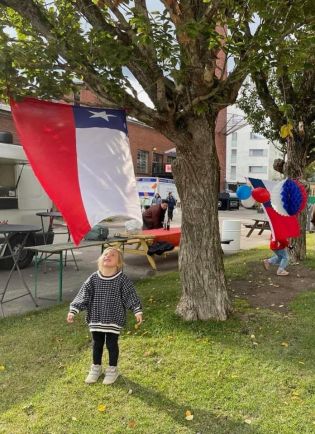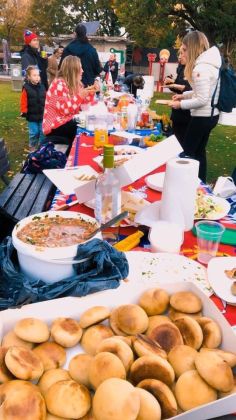Celebrating “el Dieciocho” the Independence Day of Chile in Finland
| Celebrating “el Dieciocho” the Independence Day of Chile in Finland | ||||
|---|---|---|---|---|
| In the national inventory | ||||
|
Practitioners and people who know the tradition well
The “Dieciocho”, the independence day, is one of the most important celebrations of Chilean culture and is a motive to gather with relatives and friends. It is an annual event taking place on and is practiced by a large group of Chileans living in Helsinki and elsewhere in Finland. On the other hand, not all Chileans in Finland celebrate this tradition. At present, there are more than 500 Chileans residing in Finland.
However, El Dieciocho - The Independence day - is an event practiced by a large number of the Chilean community living in Finland and it gathers participants of all ages, genders, families, relatives and unfamiliar people. Also, many of them are local participants that have some connection with the Chilean community, such as partners, friends or co-workers. People from other Latin American countries, Peru, Colombia, Argentina, Ecuador, Bolivia, etc paraticipate as well. The Spanish language works as a bridge to gather all the Latino-american participants. Therefore, el Dieciocho has become a festivity that continues year after year strengthening the Chilean cultural heritage.

This tradition started to be practiced with the first refugees in 1973 that came to Finland escaping the Pinochet regime. Chile had recently suffered a military coup and many fled. These people started to interact with the other Chileans in Finland, to create community, and to recreate a piece of home in Finland. Later, the Chilean community has grown and it has members of all ages. The Association Cultural Chile Finlandia ry is often involved in this event and organizes activities such music events or cooking food.
Practising of the tradition
El Dieciocho is the national official independence day. It’s recognized by the Chilean Government and there many different types of activities imparted by chileans residents, not only in Chile but also abroad. In Finland, the tradition has been organized lately by the Chilean community Asociación Cultural Chile - Finlandia ry tässä eri? . In 2022, the celebration was held at Kalasatama, Helsinki, attending not only Chileans, but also people from all over latinoamerica and locals. The celebration is called Ramada or Fonda. The Ramada or Fonda is one of the hallmarks of the national celebrations. Within the republican civic festivities, today called "Fiestas Patrias", the early incorporation of this particular form of sociability within the festive program stands out, a practice that persists until today. Among the traditional activities practiced at Fondas, the following activities can be mentioned: food, dance and music.
Among the facilities of the Fonda there are spaces, often more than one, with a grill and the cook. This space is for grilling different types of meat, such as: cow, lamb, pork but also vegetables. It’s also often used to warm up the Empanadas. This spot is also a place for gathering and joining the cook with a wine or some other alcoholic drink like pisco or Terremoto. During the preparation of parrillada, the cook is surrounded by friends and it’s a space to talk, have fun and drink beer.
The traditional dance called Cueca, is performed during the Fonda. There are competitions held and also a free space for dancing. Its presence can be recognized throughout the entire national territory, varying the choreographic and musical form depending on the geographical area in which it is performed, but always preserving a common pattern that makes it a unique and differentiated dance. Likewise, it has had two predominant functions. Firstly, entertainment, dancing in dinners and parties with great excitement. Secondly, the documentary function, to the extent that it acts as a transmitter of the oral tradition in the voice of popular singers. During the fondas it’s often to see people teaching each other in a relaxed environment with the company of families and children as well.
A musician or a band is often performing during the Fonda. Depending on the size of it, there can be many musicians and performances during the day, they can perform traditional folklore music or Cueca, Cumbia and Chilean popular pop music. They invite people to dance, the crowd to join and they organize dance contests. Some of them can be dressed up with the traditional Cueca outfits.
The background and history of the tradition
The first refugees came from Chile to Finland in 1973 escaping the Pinochet regime. These Chileans were the first group that Finland formally received as political refugees in its history. This event was particularly significant, because it implied an important change in what had been hitherto the established foreign policy of the country. The official size of this first group of refugees was 182. Subsequently, the number of Chileans residing in Finland gradually increased up to more than 500 nowadays, as a result of both immigration and of the emergence of second (and even third) generations.
The Ramada or Fonda, as the celebration is named, are occasional establishments that, since their inception, have expressed a deeply rooted peasant identity that revolves around food, dance, and joy. With the establishment of the Republic in the first decades of the 19th century, the recently established civic festivals were presented as a new opportunity for the popular world to reproduce its particular form of celebration. Then there was a spontaneous process of appropriation of this party by the ruling class, as they perceived the social force behind this popular custom and how convenient it was to instill feelings of adherence to the Chilean nation. Fondas can be held during 17th, 18th and 19th of September in Chile and these days are public holidays.
Particularly, “el Dieciocho”, is one of the most important Chilean celebrations. It's the commemoration of independence, specifically is the commemoration of the first legitimate Government Assembly of the Kingdom of Chile also known as the first Government Gathering for over 200 years was the organization established to rule post-colonial Chile following the deposition and imprisonment of King Ferdinand VII of Spain by Napoleon Bonaparte. It was the earliest step in the Chilean struggle for independence, and the anniversary of its establishment is celebrated as the national day of Chile.
At the time of the Spanish conquest, cattle species were introduced that grew and adapted very well to the Chilean fields. The development of the cattle was so great that the production gave milk and meat in abundance, for which reason it became very popular to celebrate for any reason with a large barbecue. For this reason, not only for National Holidays it is customary to celebrate with barbecue, but also on birthdays, anniversaries, soccer games or meetings with friends. Also, many products such as sausages, which are called: prietas, longanizas, chunchules and choripán, became very popular throughout the South American region.

As spring approaches, early September in Chile, the temperatures become more pleasant every day, the parks and squares become a meeting place for family and friends. In those days the kites fly by the hands of children and adults who are enthusiastic about this game. Everyone can choose to celebrate the National Holidays by accompanying their meals with a good Chilean wine or, if you prefer non-alcoholic drinks, prepare mote con huesillo, a refreshing drink made with dehydrated peaches (huesillos), wheat mote and juice with chancaca. Other famous "Dieciocho" drinks are: Borgona (Burgundy): strawberries, red wine, sugar and orange liqueur. Michelada: beer, lemon juice, salt, Worcestershire sauce, chili sauce, soy sauce, and pepper, Terremoto (Earthquake): grenadine, pipeño wine and pineapple ice cream.'
In the 1970s the Chileans who arrived, started to recreate a piece of home in Finland. Every year since then, the community of chileans has grown and integrated members of its community of all ages, families and also locals. The Association Cultural Chile Finlandia ry is often involved in this event and organizes different cultural activities such as concerts, art exhibitions, and the independence day “el Dieciocho”.
The transmission of the tradition
In Chile the tradition has been passed on from generation to generation through the family. Tradition is part of a lifestyle, therefore it is transmitted through parents, education and daily life. Also, it is an official government recognized holiday it is transmitted by hearing from it from the radio, television, at the school education, cooking with family relatives or friends, playing and listening to music and learning to dance the official dances at school. In Finland, the tradition is transferred through the customs associated with the celebration of Independence Day.
Particularly in Finland, these traditions are practiced and organized by Chileans. It started as a casual gathering among the first ones in the 70´s, and now organizations such as Cultural Association Chile Finland ry often disseminate information about the event. Also, there are some local businesses such as restaurants, owned by Latin Americans that had joined “El Dieciocho” with Empanadas, Pisco Sours and other traditional latin-american dishes from Perú or Ecuador, for example. The embassy of Chile also mentions every year within their facilities and website as a commemoration of the Chilean traditions, in the website it is also possible to find more information whether there is some particular activity during this date.
The future of the tradition
Chileans living in Finland have different approaches to their origins. Some feel that origins are an important part of their identity, while for others it is not such a noteworthy part of their own self-image. It is possible to find that Chileans with time become modified to a major or lesser degree by the Finnish physical and societal environment.
However, the cultural practices spread among the Chilean and foreign community are strong, since they are inscribed into a political hallmark and supported by Chilean authorities. Also, some of them are a set of traditions that are constantly being practiced and most Chileans recreate even without being aware of them, like cooking traditional dishes, for example: Empanadas, Pastel de Choclo, Cazuela de pollo, Piscola, pisco sour, and drinking wine.
There are also aspects that have changed or been modified after Chileans came to Finland. One (of many other variables) is the housing experience and this affects the spreading of Chilean culture. The surface area of apartements in Helsinki tends to be significantly smaller than average homes in Chile. This affects social interactions since hosting several people it´s not possible. Therefore, many of Chilean have become more independent or solitary, in a way mirroring the Finnish style of life.
The community/communities behind this submission
The Association Cultural Chile Finlandia ry
The article was born as part of the project of Ambassadors of Living Heritage in 2023 and was written by Valentina Bravo Zúñiga
Bibliography and links to external sources of information
Internet sources
Art, history and literature: Information of the Museum of Fine Arts and national history: Fiestas religiosas y ritos políticos en Chile colonial and Fiestas patrias
Chilean website of tourist information
Information from the Senate of Chile
Quick guide for independence day
Videos
Chilean History and Heritage (Travel Chile)
Chilean Traditional Dishes (Traditional Dishes)
History of the Holidays: Sept. 18th, Chilean Independence Day.
